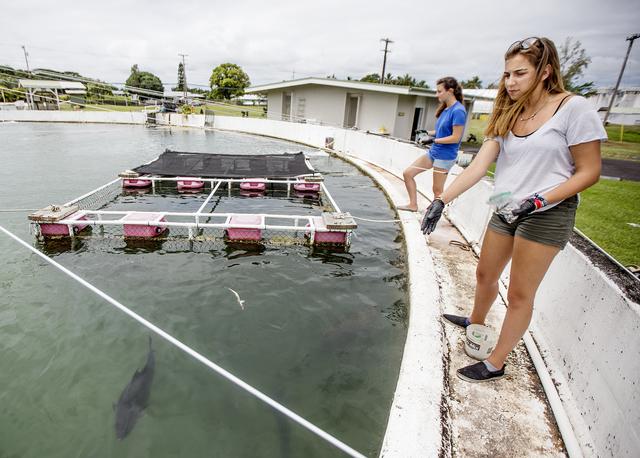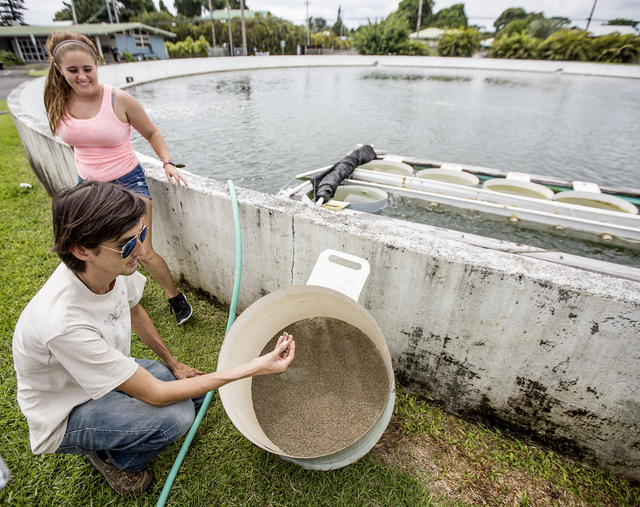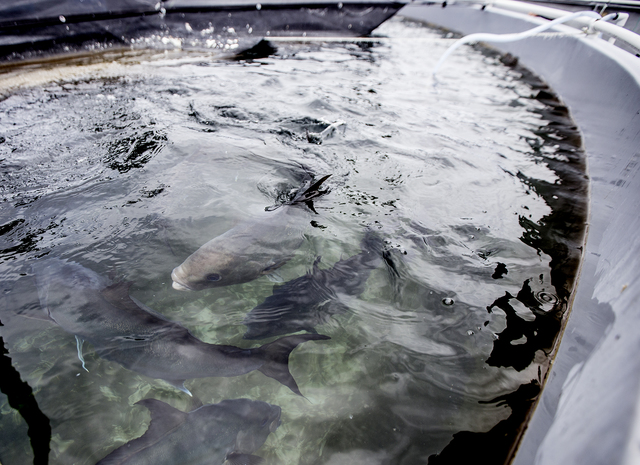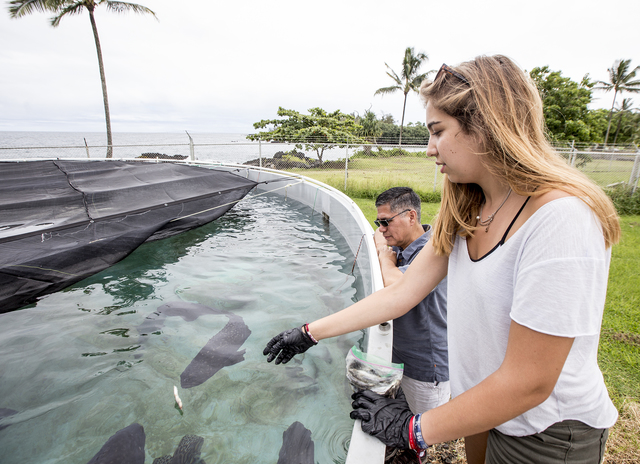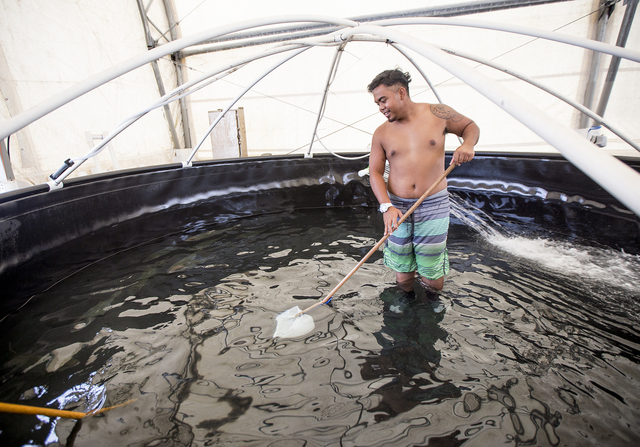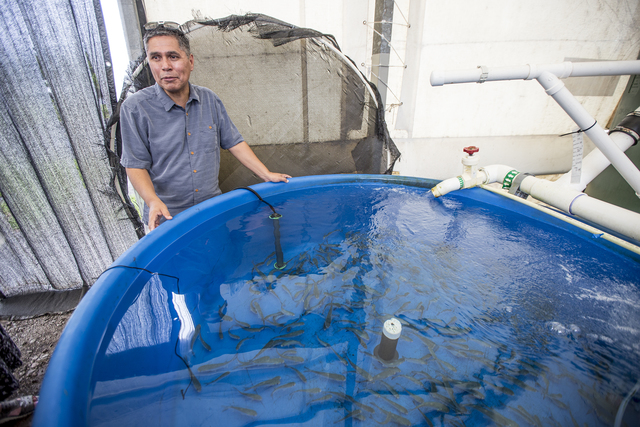HILO — On a recent Wednesday, University of Hawaii at Hilo students Anne Sophie Marques and Albane Parthenay headed out to feed the fish.
Working at the university’s Pacific Aquaculture and Coastal Resources Center site in Keaukaha, the pair donned gloves and picked up small plastic baggies of silvery sardines. They dropped the slim fish into above-ground tanks, each containing more than 33,500 gallons of seawater.
In one tank, robust yellowtail (kahala) sliced the surface with their fins and gobbled up the food. In another, large grouper gulped their breakfasts.
In a much larger tank — half a million gallons of water — yellowtail and grouper swam together, near a burbling downweller of growing baby oysters, called spat, and an in-water cage of non-native snapper.
PACRC’s latest projects, which it hopes to scale up in the coming years, focus on what sounds like a misnomer: land-based aquaculture.
“That’s kind of a different approach than most people do,” said assistant professor Armando García-Ortega.
The center began amplifying its efforts to research land-based systems about 5 1/2 years ago, after García-Ortega’s arrival, who had done similar marine research in Mazatlán, Mexico.
The aquaculture most familiar to people involves offshore cages. In other countries, where aquaculture is much more common than the United States, it has drawn controversy because of the concentration of nitrogeonous fish waste polluting the water.
Land-based systems don’t have such a problem. The waste detrimental to marine ecosystems can be cleaned out of a tank and used as fertilizer for plants. In between cleanings, it nourishes other tank-dwellers, such as oysters and plants.
“What they’re losing in the seas, we collect,” García-Ortega said. More than 1,100 pounds of sludge was removed from the half-million-gallon tank last year, he said.
The fertilizer is a useful byproduct, but it’s the fish themselves who are the main focus.
Although Hawaii is an island state with an impressive history of fishing and fish-farming culture, García-Ortega said, “We are importing more than half of the seafood we are eating … so, we are trying to let people know the importance of getting that reversed. People don’t believe it.”
According to the National Oceanic and Atmospheric Administration, more than 90 percent of seafood consumed nationwide is imported — usually from countries that practice aquaculture.
“With increasing human populations and shrinking fish stocks, we need aquaculture,” said Bruce Mathews, dean of the UH College of Agriculture, Forestry and Natural Resource Management. How to do it in a sustainable manner is another of the questions PACRC is trying to answer.
Another is how to get more people involved.
“We feel that, really, in Hawaii we have a responsibility to do this production,” said PACRC director Maria Haws. Hawaii was an early pioneer of offshore aquaculture, she said, but “we are doing very little of it.”
Working within the state’s system of permits and regulations is challenging for people who want to get involved in aquaculture. UH operates on a seawater well, Haws said: “It’s almost impossible to get a permit to take ocean water.”
“People get very frustrated when they hear the timelines they have to go through,” Mathews said.
“We just have to keep it going, get more people involved,” García-Ortega said. PACRC’s main mission is sharing its research and teachings, starting with its own student workers.
The center also hopes to perfect its own techniques enough that it can raise young fingerling fish to provide new farmers starting their own aquaculture systems.
“There’s no place in the state where you can say ‘I’d like 10 moi fingerlings and five yellowtail fingerlings,” Haws said. Demand for the fingerlings would be determined by the private sector, she said.
While not everyone can have a half-million-gallon tank (PACRC is a former wastewater plant), there are smaller backyard tanks that can be used to raise food fish, particularly the smaller mullet.
“Mullet is a favorite species all over the world,” García-Ortega said. Yellowtail and grouper are favorite local species; yellowtail in particular was chosen as a research species because of its fast growth rate.
Fish have a much higher feed conversion rate than terrestrial animals do. On average, it takes 1.5 pounds of food to make 1 pound of fish. It takes eight times more to make 1 pound of beef.
García-Ortega is researching solutions to one of the more thorny problems of aquaculture: food. The current farming model of feeding small baitfish such as sardines, as Marques and Parthenay were doing, isn’t sustainable on a large scale (the baitfish stocks would then be depleted), so García-Ortega is experimenting with how fish grow on diets that are more algae-based.
“We’re trying to get as much algae into their diets as possible,” he said. “It’s not easy to do.”
This summer, he will begin testing how the young yellowtail respond to different proportions of algae in their feed. Last year, he tested mullet on a 100 percent algae diet, “and it worked,” he said, noting that mullet are more omnivorous than grouper or yellowtail.
“Hawaii could be leading the entire world in marine fish production,” Haws said.
Email Ivy Ashe at iashe@hawaiitribune-herald.com.







